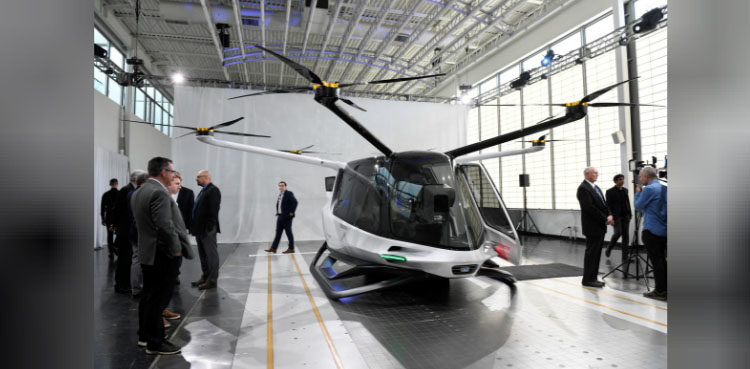First hydrogen fuel cells powered vehicle unveiled
On Wednesday in South California, Developers of the multi-rotor promoted and unveiled the full-scale model of their first flying vehicle which is powered by the hydrogen fuel cells. This model though has raised a question but is still an intriguing invention with futuristic horizons.
This futuristic aircraft named as “Skai” was put on an exhibition outside the BMW Group’s Designworks studio in Newbury Park, suburbs of the Los Angeles. This exhibition was held for the investors of this project. The other guest list included a few other invited guests and the news media.
A private company based in Massachusetts named Alaka’i Technologies contributed in the avionics and the engineering of this drone-like vehicle.
California is a region which was famous for its epic traffic jams and plagued by smog, for a region like this, the company manufacturing this aircraft promises that this airborne transport will be ideal for a region like California and it’ll also be a zero-emission mode of air transport.
Hydrogen fuel cell technology has been a field of interest for quite a time due to it being pollution free. However, automobile industries have struggled to bring its use in the mainstream automotive industry. Alaka’i, on the other hand, has mentioned that they are successful in the “world’s first hydrogen fuel cell-powered air mobility” in the form of their this new aircraft.
The mock design was displayed on Wednesday. The design resembles like a sleek five-seater SUV, having landing rooters, about the size of a minivan and with an array of six horizontal rotors which are attached with the roof of the aircraft by the ends of protruding arms. This was all about the looks.
The model which was displayed is actually the replica of the company’s only full-sized operational prototype. And Officer Steve Hanvey, Chief Executive of the Massachusetts Lab firm, stated that this prototype would soon be forwarded to the remote control test flights.
COMMERCIAL PRODUCTION
Hanvey further informed the media that the assembly of the aircraft was completed a week ago and that “they’ll be going to get off the ground immediately” as soon as they get the initial Federal Aviation Administration Certificate.
He said that they’d be able to get the FAA approval process quickly since their aircraft is relatively simple and its operating process is easy as compared to the conventional helicopters. Hence, these factors would lead from experimental to commercial production.
Hanvey further mentioned that for the initial production, they are hopeful of getting the FAA certification by the end of next year so that they would make their aircraft available for the public by 2021.
He also mentioned that the company would produce 10,000 vehicles per year, and its cost would be around that of the price of the luxury car. The aircraft would be built in three configurations which would include for emergency medical transport, for either taxi or personal passenger flights and for the cargo delivery purposes.
The six hydrogen fuel cell batteries would power the aircraft. And all 6 would be used by each motor engine. The aircraft range would be 300 range but would be mainly used for the flights within and nearby cities for short urban trips.
If we talk about the safety of the aircraft, it is equipped with an autopilot system, a parachute attached to the vehicle’s airframe and in case one motor is damaged or ruined then it has a propulsion design that it’d be able to fly easily.
Even though in case of the FAA rules and approval, the aircraft would be requiring pilot system but the developers believe that their aircraft would ultimately fly autonomously with the help of the pre-programmed guidance systems installed in the aircraft.

